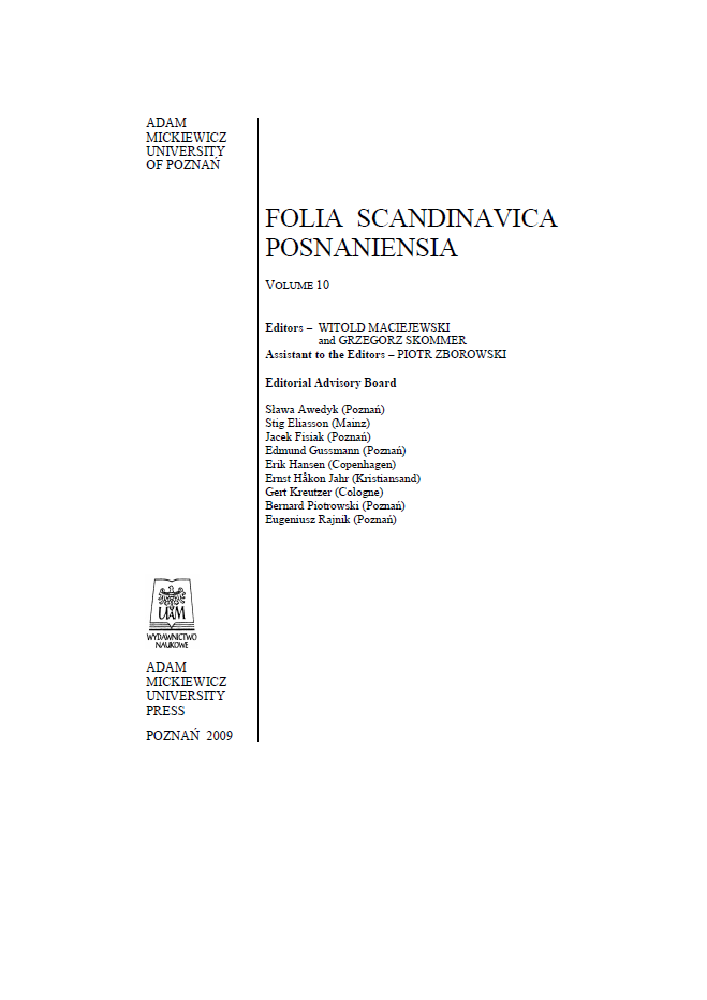Abstract
Every grammar of the Swedish language provides information concerning the unit det. The Swedish det can be used both pronominally and adnominally, fulfilling a wide range of functions in the language. However, in traditional grammar one does not pay attention to the links and mutual relations between the individual occurrences of this unit. Thus, within such a framework, the Swedish det can be treated as an extreme example of homonymy. Is that possible in language?
The main goal of this article is to show the semantic value of the unit det (in its nominal function) in contemporary Swedish, adopting the perspective of Cognitive Grammar. I shall try to prove that all uses of this unit are linked to each other semantically. Thus, the meaning ascribed to det constitutes a complex network of senses rooted in the prototype, which is a cognitive reference point within the category. The article can be interpreted in a wider context of the research concerning the use of units which are functionally “related” to the Swedish det in various languages, e.g. the English it, the German es, the Polish to etc.
References
Bolinger, Dwight. 1977. Meaning and form. New York: Longman.
Brandenstein, Wilhelm. 1928. Das Problem der Impersonalien. Zeitschrift für Indogermanistik und allgemeine Sprachwissenschaft 46, pp. 1-26.
Brugmann, Karl. 1922. Kurze vergleichende Grammatik der indogermanischen Sprachen. Berlin – Leipzig: Walter de Gruyter & Co.
Brugmann, Karl. 1925. Die Syntax des einfachen Satzes im Indogermanischen. Berlin – Leipzig: Walter de Gruyter & Co.
Chomsky, Noam. 1982. Lectures on government and binding. The Pisa lectures. Doordrecht – Cinnaminson: FORIS.
Data-Bukowska, Ewa. 2005. Zaimki wskazujące w języku szwedzkim. Analiza znaczeń z perspektywy językoznawstwa kognitywnego. Kraków: TEXT.
Hanks, Wiliam F. 1992. The indexical ground of deictic reference. In: Duranti, Alessandro & Goodwin, Charles (eds.). Rethinking context. Language as an interactive phenomenon. Cambridge:
Cambridge University Press, pp. 43-76.
Himmelmann, Nikolaus. 1996. Demonstratives in narrative discourse: a taxonomy of universal use. In: Fox, Barbara (ed.). Studies in anaphora. Amsterdam – Philadelphia: John Benjamins, pp. 205-253.
Jodłowski, Stanisław. 1973. Ogólnojęzykoznawcza charakterystyka zaimka. Wrocław – Warszawa – Kraków: Wydawnictwo PAN.
Krenn, Monika. 1985. Probleme der Diskursanalyse im Englischen. Verweise mit ‘this’, ‘that’, ‘it’ und Verwandtes. Tübingen: Gunter Narr Verlag.
Lakoff, George. 1987. Women, fire, and dangerous things. What categories reveal about the mind. Chicago: The University of Chicago Press.
Langacker, Ronald W. 1987. Foundations of cognitive grammar. Vol. I: Theoretical prerequisites. Stanford: Stanford University Press.
Langacker, Ronald W. 1991. Foundations of cognitive grammar. Vol. II: Descriptive application. Stanford: Stanford University Press.
Lyons, John. 1977. Semantics, 2 Vols. Cambridge: Cambridge University Press.
Mulder de, Walter. 1996. Demonstratives as locating expressions. In: Pütz, Martin & Dirven, René (eds.). The construal of space in language and thought. Berlin – New York: Mouton de Gruyter, pp. 29-46.
Olson, Emil. 1913. Studier över pronomenet den i nysvenskan. Lund: Gleerup.
Roberts, Lawrence D. 1993. How reference works. Explanatory model for indexicals, descriptions, and opacity. Albany: State University of New York Press.
Schultze, Brigitte & Tabakowska, ElŜbieta. 1992. The Polish discourse marker ‘to’ in Gombrowicz’s “Ślub” (“The Marriage”) and its English, German, French and Czech translations: cognitive linguistics and poetics of the theatre text. Mainz: Liber.
Smith, Michael B. 2002. The polysemy of German ‘es’, iconicity, and the notion of conceptual
distance. Cognitive Linguistics 13(1), pp. 67-112.
Sokołowska, Olga. 2002. The pronouns ‘it’ in English and ‘to’ in Polish – cognitive implications. In: Lewandowska-Tomaszczyk, Barbara & Turewicz, Kamila (eds.). Cognitive linguistics today.
Frankfurt am Main: Peter Lang, pp. 595-608.
Tabakowska, Elżbieta. 1995. Language in time and space: the concept of radial category and polysemy. (A study of the Polish lexical item TO). In: Smoczyński, Wojciech (ed.): Analecta Indoevropaea Cracoviensia: Ioannis Safarewicz memoriae dicata. Kraków: Universitas, pp. 429-441.
Teleman, Ulf, Hellberg, Staffan & Anderson, Erik. 1999a. Svenska Akademiens grammatik. Ord. Stockholm: Norstedts.
Teleman, Ulf, Hellberg, Staffan & Anderson, Erik. 1999b. Svenska Akademiens grammatik. Fraser. Stockholm: Norstedts.
Teleman, Ulf, Hellberg, Staffan & Anderson, Erik. 1999c. Svenska Akademiens grammatik. Satser och meningar. Stockholm: Norstedts.
Thorell, Olof. 1973. Svensk grammatik. Stockholm: Norstedts.
License
Copyright (c) 2015 Ewa Data-Bukowska

This work is licensed under a Creative Commons Attribution-NonCommercial-NoDerivatives 3.0 Unported License.
